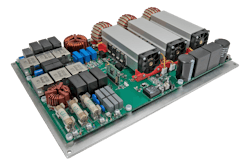Microchip Technology Expands High-Power SiC Lineup
Silicon carbide (SiC) power semiconductors are surging in adoption, particularly in hybrid and electric vehicles, and for good reasons. Users of SiC in high-power switching applications (600 V or more) reap the benefits of smaller size, lighter weight, and lower overall costs. Even more importantly, SiC offers improved system efficiency, high power density, and high temperature stability.
With an eye toward capturing its share of what’s forecast as a $10 billion market by 2027, Microchip Technology is shaping up its SiC power semiconductor offerings to address the growing demand for these devices.
Microchip Technology’s SiC product portfolio spans discrete, die-level, and modular-packaged devices, with an emphasis on delivering a total system solution that covers control, drive, and power applications. Included in the latest offering are SiC Schottky barrier diode-based modules rated for 700, 1200, and 1700 V; the module topologies include dual diode, full bridge, phase leg, dual common cathode, and 3-phase bridge.
Within the modules are the newest generation of Microchip’s SiC die, which maximize system reliability and ruggedness for long, stable service life. The devices’ high avalanche performance reduces the need for snubber circuits, while their body diode stability allow designs to use the internal body diode without long-term degradation.
To help designers get going on SiC-based, system-level solutions, the company has announced reference designs and evaluation kits. One example is a 30-kW, 3-phase front end for a charging station application that uses 1200-V SiC Schottkys and 700-V SiC MOSFETs (Figure 1). These reference designs and boards give system developers tools with which to reduce development cycle times. Also available are SPICE models and an SiC driver board reference design.
Another element of the overall system-level solution is the company’s AgileSwitch digital programmable gate drivers, which provide reliable and efficient control of SiC MOSFETs. Standard analog gate drive implementations often suffer from varying degrees of ringing, overshoot, and undershoot. AgileSwitch gate drivers use a technique the company calls augmented switching. Using software programming that defines the amount of time spent in turn-on, plateau, and turn-off, the devices reduce VDS overshoot by up to 80%, cut switching losses by up to 50%, and provide robust and fast short-circuit protection. As a result, gate-drive implementations won’t cause false faults, mitigate ringing, and reduce EMI.
Microchip’s 700-, 1200-, and 1700-V SiC power modules are available now.
Microchip Technology, http://www.microchip.com/sic
About the Author
David Maliniak
Executive Editor, Microwaves & RF
I am Executive Editor of Microwaves & RF, an all-digital publication that broadly covers all aspects of wireless communications. More particularly, we're keeping a close eye on technologies in the consumer-oriented 5G, 6G, IoT, M2M, and V2X markets, in which much of the wireless market's growth will occur in this decade and beyond. I work with a great team of editors to provide engineers, developers, and technical managers with interesting and useful articles and videos on a regular basis. Check out our free newsletters to see the latest content.
You can send press releases for new products for possible coverage on the website. I am also interested in receiving contributed articles for publishing on our website. Use our contributor's packet, in which you'll find an article template and lots more useful information on how to properly prepare content for us, and send to me along with a signed release form.
About me:
In his long career in the B2B electronics-industry media, David Maliniak has held editorial roles as both generalist and specialist. As Components Editor and, later, as Editor in Chief of EE Product News, David gained breadth of experience in covering the industry at large. In serving as EDA/Test and Measurement Technology Editor at Electronic Design, he developed deep insight into those complex areas of technology. Most recently, David worked in technical marketing communications at Teledyne LeCroy, leaving to rejoin the EOEM B2B publishing world in January 2020. David earned a B.A. in journalism at New York University.


